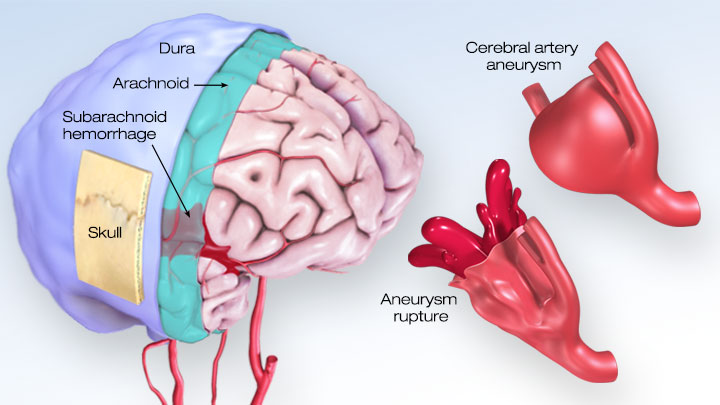
Subarachnoid Hemorrhage (SAH)
What is a subarachnoid hemorrhage?
A subarachnoid hemorrhage occurs when a blood vessel bursts near the surface of the brain and blood leaks in between the brain and the skull.
This blood may cause nearby arteries to spasm, and that reduces blood flow to the brain and causes a stroke.
This type of stroke can be caused by different things, but is usually caused by a burst aneurysm. An aneurysm is a weak spot on the wall of an artery that bulges out into a thin bubble.
As it gets bigger, the wall may weaken and burst. If it bursts, blood leaks inside or around the brain.

What are the symptoms of SAH?
Typically, there are no warning signs of a SAH. Occasionally, an aneurysm is detected through a warning leak. These small leaks may cause headaches prior to a more damaging SAH.
The symptoms of a SAH include:
- Sudden severe headache – often described as the “worst headache of my life”
- Vomiting or nausea, especially when combined with other symptoms such as headache
- Intolerance to light
- Stiff neck
- Loss of consciousness, especially when combined with a severe headache
How is an SAH Treated?
Treatment of SAH targets the cause of bleeding and its related complications. Ruptured aneurysms are generally repaired through direct surgery to clip the aneurysm or treating the aneurysm from inside the vessel.
Operating on the aneurysm from the inside, called embolization, is done by guiding a small metal coil through the brain artery until it reaches the aneurysm.
Once there, the coil allows for a clot to form and prevent more blood from entering. A vessel-narrowing condition called vasospasm is also a common cause of death and disability following a SAH. Vessels in vasospasm become irritated by blood and begin to spasm.
As the vessels narrow, it becomes more difficult to supply surrounding brain tissue with enough blood to survive. This condition occurs in at least thirty percent of all subarachnoid hemorrhages. It generally lasts for two or more weeks after the first vessel rupture.
Vasospasm treatment often includes the use of the oral medication, nimodipine. Taking the medication exactly as prescribed is critical to control the condition. Doctors may also manage vasospasm by closely monitoring the pressure, volume and concentration of blood in the brain.
